News
17 May 2025
The Signing Mind Seminar Series
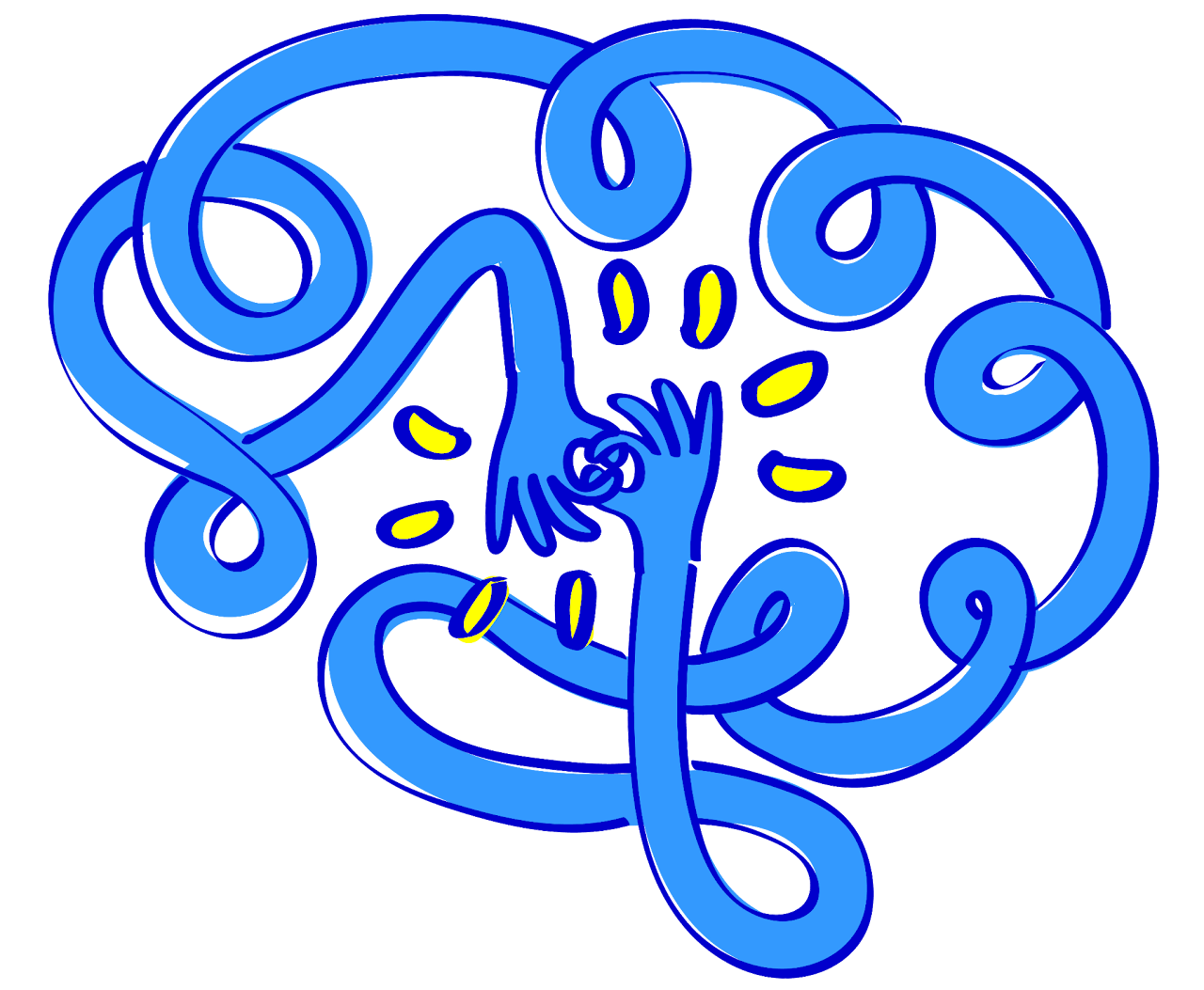
New seminar series that explores the organization of the lexicon in sign language using word association methodology starting in May 2025. The Signing Mind Seminar Series features researchers whose work is relevant to the overall topic of how sign language lexicons are organized in form and meaning, with a special focus on the methodology of free/word associations. The series will include presentations on both signed language research and spoken language research that uses methodologies or analyses that can inform work on sign languages.
The first presentation will be by Zed Sevcikova-Sehyr (Cognition, Language and Plasticity Lab, Chapman University, USA) on Monday, 19th May at 17h (CEST; UTC+2).. The presentation title is: “It’s a Small World” of Signs: Semantic Network Structure in American Sign Language (full abstract available on the Signing Mind website.
The series will consist of around six online presentations throughout the year. The seminar languages are English and International Sign (with interpreting between both). Presentations will typically be on Monday afternoons (European Time), though this schedule depends on the speaker's availability and time zone. Presentations will be recorded and made publicly available. Links to attend presentations via Zoom will be sent out via the Signing Mind mailing list.
The series is part of a joint collaboration between two projects: SemaSign, led by Hope Morgan at the University of Hamburg, and SIGNifica, led by Brendan Costello at the BCBL (Basque Center on Cognition, Brain and Language). Both projects examine the semantic network of the sign language lexicon by collecting free association data in different sign languages.
To receive information about upcoming presentations, join the mailing list or check the programme website.
4 December 2020
New article on word associations and official SWOW-JP launch
Maria Telegina at the University of Tokyo has joined forces to kickstart the Japanese Small World of Words project. To mark the occasion, she wrote a blog post to give an update of the project (see below). The full post can be found here.
When you smell coffee, what picture appears in your mind? What do you feel? What time of the day do you imagine?
Distinctive smells like the smell of coffee tend to trigger strong associations. In the same way as the smell of coffee is associated with the process of waking up in the morning or staying awake during the day, words ‘coffee’ and ‘morning’ or ‘coffee’ and ‘break’ can be associated with each other.

Access to social, cultural, and semantic knowledge is the reason why word associations have been considered a source to get access to processes of the human mind and to model its conceptual structures for more than hundred years. The first examples of such use of the associations can be found in the works of such psychologists as Carl Jung and Francis Galton. For instance, Jung used word associations as a technique to get access to and then analyse the manifestations of subconscious of his patients.
The development of technology in recent decades has played a big role in the ways word association data are collected, organized, and studied. Today researchers all over the world can collaboratively learn various aspects of the human mind through analysis of word associations in different languages. A complex of these aspects is usually referred to as ‘mental lexicon’. Mental lexicon is also sometimes called one’s ‘mind dictionary’. Today the researchers can build large scale models of the mental lexicon and investigate its conceptual structure with datasets counting over 5 million responses, e.g. English Small World of Words
Though the approaches to the analysis of word associations have changed over the century, the typical task of a word association experiment remains the same – participants are asked to write down the first word(s) which come to their mind when they see a cue word. Such a word association experiment is usually called a ‘free word association experiment’, as the participants have the freedom to answer with any association they come up with.This simple task gives researchers material to investigate a great variety of features of the mental lexicon and make discoveries about memory, language development, creativity, and individual differences.
One such discovery is that the nature of the associations produced by the participants is interconnected with their age. This discovery was confirmed in works on associations in different languages, e.g. Portuguese, Japanese, Spanish. Research demonstrates that through our lifetime from childhood to adulthood, we don’t only grow our lexicon, we enrich our mental lexicon with new connections. In other words, we learn more words and we connect words more and more with each other when we grow up. Further observation of differences in responses of participants of different ages is thought to be a tool to learn about the development of and changes in the ways we understand and conceptualize things through the lifetime.
This and many more observations and further in-depth studies can only be conducted with sufficient datasets, giving the researchers a big sample from a different age, gender, education level, regional groups of participants. In the international project of Small World of Words, such samples have already been collected for English, Dutch and Spanish. Over 100, 000 volunteers took part in each of the projects. Moreover, the English project received the “Best Paper of the Year” award from the Psychonomic Society in 2019, and its data have already been downloaded by over 2000 researchers.
This fall we are starting a Japanese version of the Small World of Words project. In our project, we will investigate the features of the Japanese mental lexicon at the scale it has not been looked at before. Along with research on gender- age- region- based differences in Japanese native speakers’ word associations, the Japanese Small World of Words will document and investigate such fundamental concepts of the Japanese mental lexicon as time, space, emotions, human relations, and family. Plans for the future development of the project include cross-cultural and cross-linguistic comparison both in terms of the structure of the mental lexicon and of individual conceptual structures. In the long-term perspective, we are planning to create multilingual tools for science-based language learning support.
You can try the Japanese version of the Small World of Words. The word associations take only 5 minutes of your time. You might or might not learn something new about yourself, but what we do know is that your contribution to this study will help us to learn the nuances of the Japanese mental lexicon, its culturally specific features, and similarities with other languages.
21 July 2019
New network visualizations in 3D
Everything is better in 3D! Network visualizations provide powerful ways to convey a lot of information at once, but even with a small set of nodes they can become confusing quickly. To make it easier to explore the associations between words in a network, a new three-dimensional visualization method is now available. You can try it out yourself by clicking the visualize menu at the top of this page and selecting the 3D Network method under the options button ().
An example for the forward association network of word is shown on the right. The new visualizations are interactive. You can zoom and pan to change the view but also
click on each word to center them. Similar to other visualizations you're able to search for multiple words at once by adding a comma between them in the search box.
There's also an option shown for each network to animate it similar to the illustration.
The different colors correspond to clusters of words that are related in some way. The clusters (aka communities) are calculated for each network visualization and will thus depend on the search terms used. In the example, we see words with similar meaning like game, games, and play clustered together.
Feedback is always welcome but note that some of the features are still experimental and might not work on every browser. Interacting with the graph should work on a computer but might be less ideal on phones, tablets, or other touch devices. The functionality might be extended in the future to explore the networks in VR if I get a hand on a headset.
Credit goes to Vasco Asturiano for developing the 3d-force-graph library that's making this possible and to Corneliu Sugar for making the jLouvain community detection library available.
12 June 2019
Small World of Words at MoD Hedonism Exhibition
The Small World of Words project will be featured in the "Its my pleasure" digital installation by Owen Churches as part of the Hedonism Exhibition at the brand new Museum of Discovery (Mod) in Adelaide, Australia.
This installation explores the how recommendation engines affect our lives. Whether we are using them to navigate the news, find friends or digest dinner,
there is a sense in which we are always asking for the algorithm to deliver us the same thing: our greatest pleasures.
To find out more, check out Owen's blog post or try out the digital installation online.
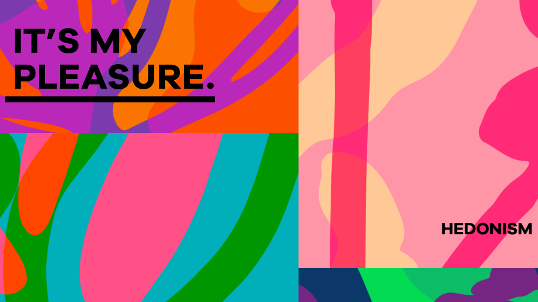
Entry to the exhibition is free and runs from May 2019 to November 2019. Check out the museum website for more information if you'd like to visit.
23 October 2018
English Small World of Words study published
It is my pleasure to announce that the English Small World of Words (SWOWEN-2018) study is now published in Behavior Research Methods.
It consists of 3.6 million word association responses to over 12,000 cue words. Nearly 90,000 volunteers have contributed to what is now the largest publicly available resource about the mental lexicon in English.
It covers over 80% of the words we use in daily language, and hopefully we can increase that number in the coming years.
In the Behavior Research methods paper we explain how these data can be used to accurately predict how we process words and their meaning through a
mechanism of spreading activation,
in which meaning is derived by direct and indirect connections a word has with other words in networks similar to those you can visualize on this website.
Thanks again to all volunteers and colleagues who helped making this possible.
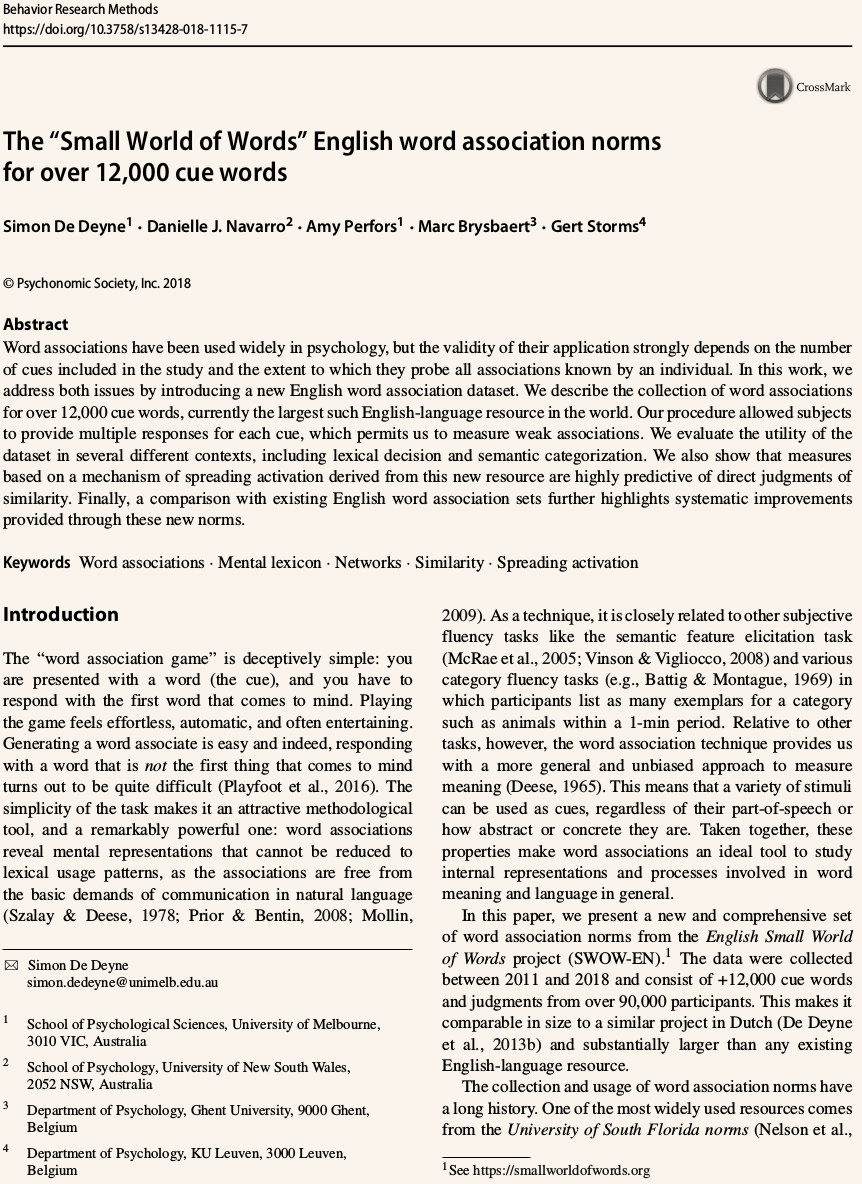
15 October 2018
Rioplatense project in the news
In the last few months, the Rio Platense project has been growing steadily. So far nearly 20,000 people have contributed to the first linguistic resource of this kind for Spanish speakers in Uruguay and Argentine.
If you speak Spanish you might want to learn more about the Rio Platense Small World of Words project by checking a new El Pais news article or listening to a broadcast from Sarandi Radio where you hear more from the lead investigator Álvaro Cabana.
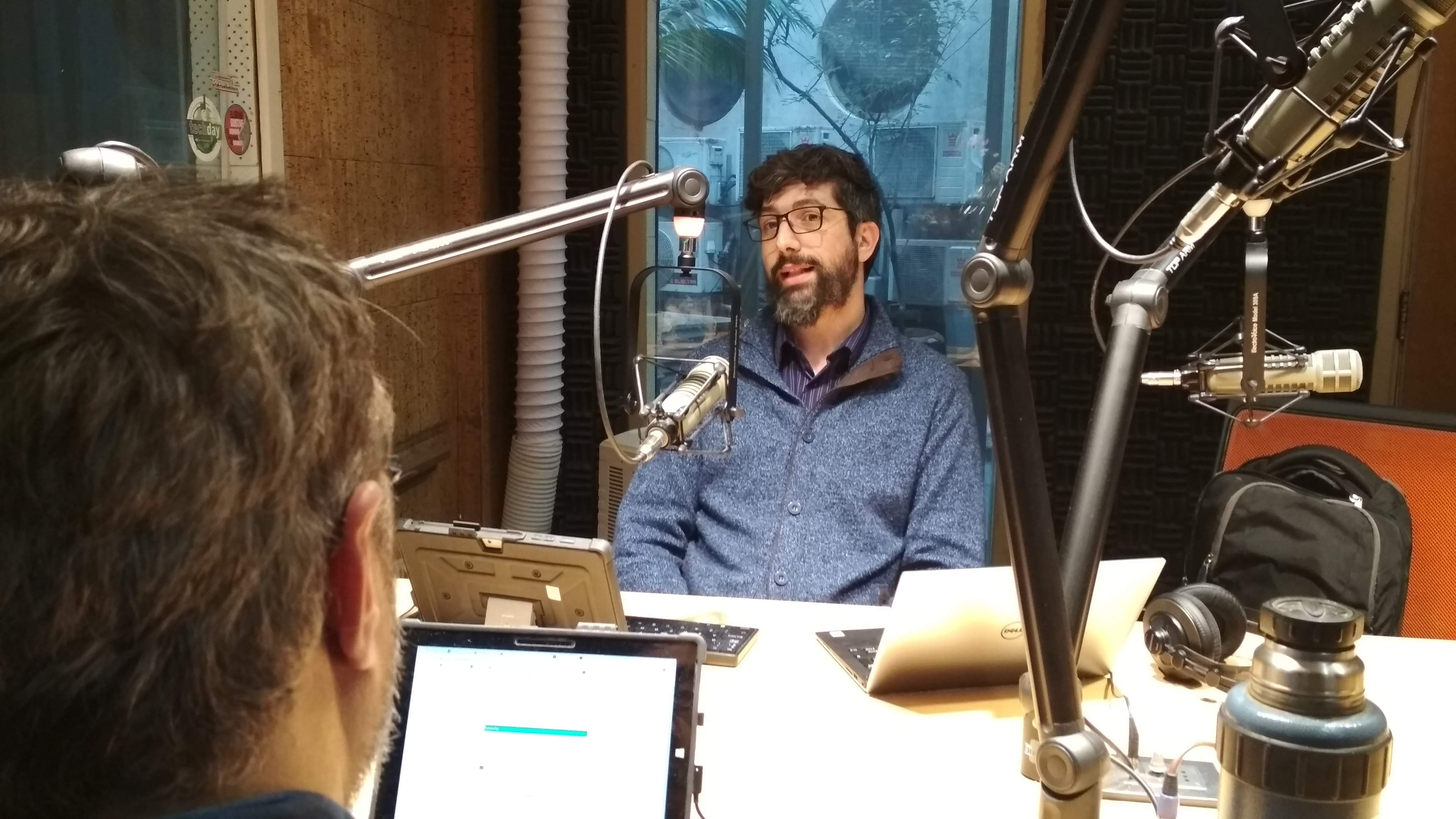
11 October 2018
The Small World of Words in Bahasa Indonesia
Halo! Apa kabar? Yes, that’s Indonesian language! Maybe some of you have never heard about Indonesian language or Bahasa Indonesia, but this language is spoken by the fourth most populated country in the world, making it as the seventh most spoken language in the world after French (according to Ethnologue, 2017, 20th edition).
Indonesia as an archipelago country has hundreds or even thousands of spoken languages. Bahasa Indonesia has been used as lingua franca, not only among multilingual Indonesians from different islands and provinces, but centuries ago it was used as a trading language between the locals and the traders.
This rich history makes Bahasa Indonesia is a unique language composed of words coming from different languages all over the world, such as Dutch, Arabic, and Portuguese. With these unique features, it will be interesting to compare the association network of Bahasa Indonesia with other languages.
The lead investigator on this project is Farah Djalal. Farah is an Indonesian lecturer and researcher from Bina Nusantara University, who is interested in her own native language and on how people use language to categorize objects. If you want to know more or have any questions (either in Indonesian or in English) please do not hesitate to get in touch: [email protected].
Selamat mencoba!

6 January 2017
Network visualizations
The network visualizations have been updated and now include bubble plots and various way to represent the word assocation data as a network. It's now possible to specify a forward, backward or related network. In each case, they give you a slightly different perspective. For forward networks, the links indicate the responses to a cue word. For the backward network, the links indicate the opposite relations, namely the cue words for the responses. The related networks takes into account how similar two words are by calculating how similar their responses are. To change the visualization type, simple press on the option icon .

You can now also look for multiple key words by entering words in the search box divided by commas. The figure shows an example. You'll also notice different colors in this network. These colors correspond to tightly connected regions in the network. These clusters or "communities" of words, are obtained using the Louvain community detection algorithm and are determined in an automatic (unsupervised) fashion. The nice thing about this style of visualization is that it automatically shows how multiple words are related and what links contribute to this relatedness.
You can also explore these networks interactively, by clicking their label and drag the nodes by holding down the left mouse-button. Another fun way to explore the mental dictionary and you don't feel inspired is by choosing a random word. Just press the icon.
10 May 2016
New version of Small World of Words now online
After 6 years, the Small World of Words project is moving to a new home and an entirely new website. Most pages from smallworldofwords.com are now available at the new domain smallworldofwords.org. If you link to the project, please update the URL.
The new website aims to make things more accessible for everyone who's interested in words and language by providing easy lookup and visualization tools. While still a work in progress, you can now lookup words in different languages and access most parts of the website in your own language. Moreover, the dictionary will now reflect an up-to-date snapshot of the lexicon. Besides getting to play with the data collected in this project, the word association game has also been improved to work better on mobile devices and a couple of languages have been added to the project (Chinese, Italian, Portuguese and Russian), so give it a go.
In the coming months the visualization tools will be further improved and the research page will be updated as well.
In the mean time, access to the data and some additional
visualizations remain accessible at the smallworldofwords.com research page.
Suggestions or feedback are always much appreciated, just mail [email protected].
23 March 2014
Rio Plantense Spanish joins Small World of Words project
Rio Platense Spanish is a form of Spanish spoken in Uruguay and Argentine. Researchers Álvaro Cabana, Camila Zugarramurdi and Juan Valle Lisboa at the Faculty of Science and Psychology in Uruguay are putting their shoulders under the first word association study on Rio Platense Spanish. In just a couple of months already over 3,000 persons have contributed to this study.
More details about this project are available in an article title Jugar con las palabras y la mente.
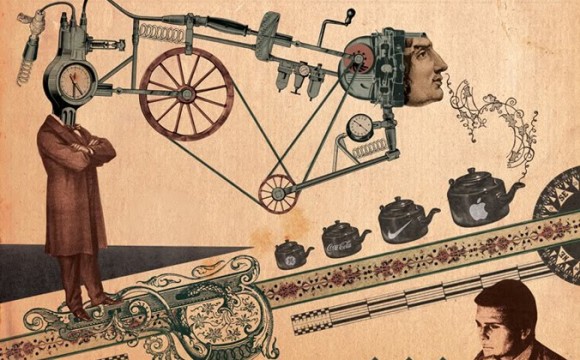
23 December 2013
Launch of Vietnamese Small World of Words
Xin chào bạn! A new Vietnamese version of the small world of word study in collaboration with Hien Pham is now available online at http://smallworldofwords.com/viet. If you are a native or fluent Vietnamese speaker, you can help us participate and pass it on to your family members and your friends.
Similar to the studies in French, German and Japanese, this set starts of with 1,000 cues that are frequently used. Please let us know what your experiences are. Happy playing! Chơi trò chơi từ vựng này sẽ giúp phản xạ ngôn ngữ nhạy bén hơn. Hãy giúp con bạn thúc đẩy khả năng ngôn ngữ với trò chơi này.
For more information about the Vietnamese project please contact Hien Pham, University of Alberta [email protected]
26 October 2013
New Japanese Small World of Words
ようこそ! A new Japanese version is now available online at http:/www.smallworldofwords.com/jp. If you are a native Japanese speaker, you can help us pilot this study, or better yet, participate and pass it on to your friends. Similar to the studies in French and German, this set starts of with 1,000 cues that are frequently used. There are some peculiarities handling non-western characters, so at this stage, please let us know what your experiences are...
Special thanks to Chie Nakatani for help with the translations and many useful suggestions!
25 September 2013
Detailed images of the mental lexicon
A new visualization shows the entire mental lexicon in English (or at least the 7,000 words collected so far). Node size indicates how important a node is in terms of incoming links (in-strenght). The transparancy of the edges is indicated by edge-betweenness.
Notice the emergence of a handfull of hubs in the lexicon. The hubs are visible as large red nodes and indicate which nodes are central in the network: work, love, food (...almost matching the Maslow's hierarchy of needs). A more detailed image is available here.
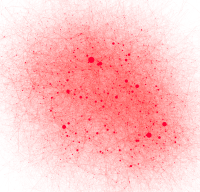
24 September 2013
Citizen Scientists Decode Meaning, Memory and Laughter
The Small World of Words Study is featured on the Scientific American Blog in a guest blog by Joshua Hartshorne at the Computational Cognitive science group at MIT. Be sure to check Verbcorner as well for a related approach to learn the meaning of a large set of words through 'Citizen Science'. A short piece in the printed version of Scientific American is expected to appear beginning next year.